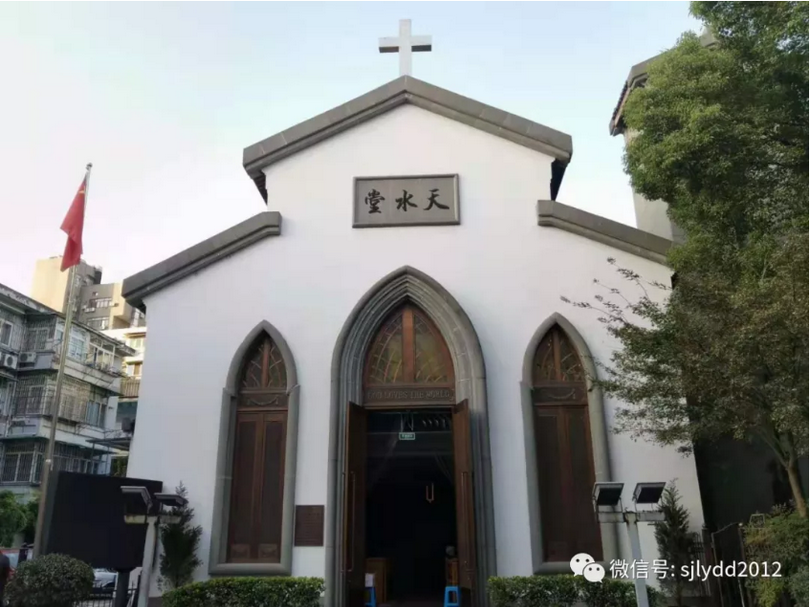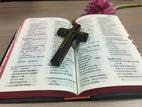On November 15th, I visited Tianshui Church in Hangzhou, which is the earliest of the five Christian churches in Hangzhou.
Tianshui Church's history dates back to 1860, when the first missionaries, M. H. Houston and Benjamin Helm of the Southern Presbyterian Church of the United States, came to Hangzhou to preach the gospel. After they arrived, they first established a site in the city's Chenghuang Hill where some houses were built. These houses happened to be facing a local official's house. The official's son was sick and was told by a Feng Shui master that it was because of the bad influence on them by the foreigners. Because of the wise arrangement by the official, the houses were exchanged and moved to a larger 10 acre area that was also the poorest. Subsequently a chapel was built there.
It reminds me of the Biblical story in Genesis of Gerar's herdsmen quarreling with Isaac's herdsmen for wells. Dubose, Yu and other missionaries could have refused to move out of wanting to strive harder, but they still chose harmony by showing sympathy to the local official's concerns and decided to make concessions. Unexpectedly, this move won the church a larger "field" in which to minister.
John Linton Stuart (1840-1913, John Leighton Stuart's father), was a pastor of the American Southern Presbyterian Church. He came to Hangzhou in 1868 when he was a bachelor, to diligently study Chinese in preparation for missionary work. Later, he returned home for health reasons. In the summer of 1874,he and his bride came to Hangzhou again. On the site of the chapel founded by Houston and Helm, Stuart and his fellow workers demolished the bungalows to rebuild the chapel, and officially named it the Tianshui Christian Church.
Behind the chapel were the two newly built houses for missionaries, men's and women's study rooms and 5-6 dormitories, which together is a large complex. More than 80 acres was added as part of the land for construction. In 1875, M. H. Houston and Benjamin Helm retired, and Stuart was appointed as the minister of the Tianshui Church responsible for the entire ministry of the church. He opened a hospital, a medical centre, a school and a reception nursery. Because of the presence of the church, over time, people called the place where it is located, Church of Jesus Lane.
Stuart founded a school and his wife opened China's second girls' school. She was also the principal of the school, which later became a part of the prestigious Hangchow Union Girls School.
John Leighton Stuart had four brothers, he being the oldest. As a child, the brothers liked to go hiking on the outskirts of Hangzhou, and they went as far as Dengzhou to see Dr. Calvin Wilson Mateer. Leighton liked Chinese food, snacks and fruit. He enjoyed attending Chinese weddings and festivals. He later deeply regretted that he had not been able to attend a Chinese school in his early years.
As a child, he often went out to the streets and to fairs with his father to preach the gospel. What this resulted in is not known. Yet the people of Hangzhou were amused by his father's dress and manners. In 1882 when Leighton was 11, his father took four of his brothers back to the United States for a year.
Stuart the senior preached in Hangzhou for 46 years. In January 1913, he died in Hangzhou at the age of 73 and his body was buried in the Jiulisong Cemetery in Hangzhou.
After the senior Stuart's death, the missionary's work was done by a Chinese pastor. Religious activities ceased after the Hangzhou Church were conjoined in 1958. Following the implementation of the policy of religious freedom in 1984, the church claimed back part of the property and underwent initial renovations which were completed in September 2009 in order to restore its worship service.
The current Tianshui Church is a Chinese-style building with a distinct Jiangnan style: the exterior walls are white, the roof is covered with small green tiles with each of the wall's corner carved with lily-patterned bricks; the doors and windows are made of western-style spires. Above the door is written in English, "God loves the world". The doors and windows are brown and the cross on the roof is white. It can be described as a combination of Chinese and western, exquisite and elegant.
The church building faces south and there is a plaque donated by the Developing Virtue Secondary School l hanging inside the church that reads, "Blessed to have Jesus". On the wooden bars of the east wall of the main hall stands a wooden pillar on which are the Beatitudes from the Sermon on the Mount.
Later, a pastor friend in Hangzhou told me that in a photo of the junior Stuart's return to Tianshui Church in October 1946, the second sister in white in the front row is his grandmother Zhang Fan, who had worked as a translator for Leighton. And his grandfather, the fourth pastor of Tianshui Church mentioned above, is Zheng Yingyu. He himself is currently engaged in theological education. He told me the story of his grandmother and grandfather in detail.
Zhang Fan was born into a Christian family with her father being a pastor. She was devout and faithful to the Lord from an early age and was an avid evangelist. At the age of nine, when her parents entrusted her to send bread to an elderly woman who had been a vegan for her whole life out of her Buddhist belief, she said to the woman, "Only by faith in God can we live forever and nothing else can save us." By the work of the Holy Spirit, the woman willingly accepted the Lord Jesus into her life. In order to celebrate, she invited guests and immediately ordered meat dumplings, no longer having issues with eating meat.
Zhang Fan, after graduating with excellent results, stayed on as a female teacher in Hangchow Union Girls School . In 1934, she entered the Bible Teachers' Training School for Women. After graduation, she worked as a teacher at the Chekiang-Shanghai Baptist Mission, often traveling to Ningbo, Jinhua, Shaoxing, Huzhou and other places for Bible training. During that period, despite many times encountering peril because of the Japanese invaders, she was delivered from danger by the Lord's protection.
Zhang Fan lived frugally, saving her monthly salary partly to fund his father's construction of Xiaofeng's first church and the rest to train his younger siblings to read.
In 1944, Zhang Fan married Pastor Zheng Yingyu of Tianshui Church and then taught music at Hangzhou Bible School, assisting her husband in his ministry as well as teaching the piano and committing to visiting fellow believers. She spoke fluent English, and at that time, foreign guests such as Stuart the junior came to Tianshui Church and so she worked as a translator and receptionist. In 1958, Pastor Zheng was accused of being a rightist, was suspended from his work and lost his salary. In those difficult times, Zhang Fan never expressed bitterness and sorrow and in the yard where she lived could often be heard singing hymns in the morning.
In 1960, due to chronic malnutrition Zhang Fan got hepatitis and the lack of treatment led to the hardening of her liver. In the people's eyes, her time left was very limited. But a year later, through divine healing, her abdominal issues disappeared. In 1979, after the GuLou Christian Church resumed operating, Zhang Fan continued to preach, play for worship, lead Bible studies and visit fellow Christians. Two months before her death she was still involved on the worship team. On the evening of August 18, 1991, Zhang Fan passed away peacefully.
On Zhang Fan's tombstone is engraved a couplet that says: "The tomb is not the end of life, heaven is the destination of believers." She had wished that after she had left the world she could continue to preach the gospel to passers-by.
Ah! It turns out that faith is passed down from generation to generation like this.
- Translated by Charlie Li












